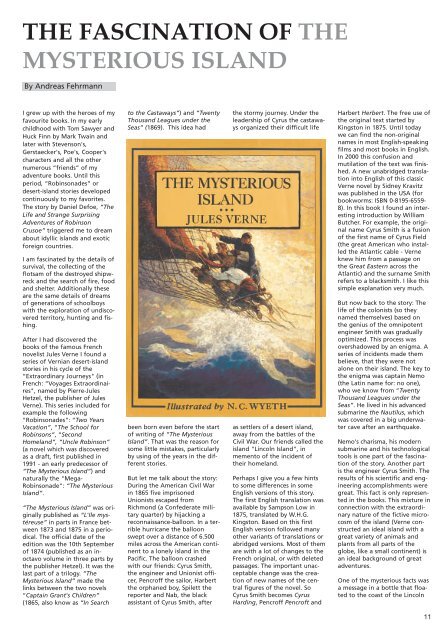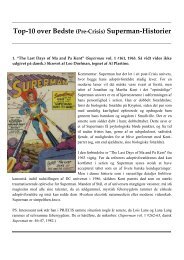Obskuriøst nr.4 - samlersind.dk
Obskuriøst nr.4 - samlersind.dk
Obskuriøst nr.4 - samlersind.dk
Create successful ePaper yourself
Turn your PDF publications into a flip-book with our unique Google optimized e-Paper software.
THE FASCINATION OF THE<br />
MYSTERIOUS ISLAND<br />
By Andreas Fehrmann<br />
I grew up with the heroes of my<br />
favourite books. In my early<br />
childhood with Tom Sawyer and<br />
Huck Finn by Mark Twain and<br />
later with Stevenson's,<br />
Gerstaecker's, Poe's, Cooper's<br />
characters and all the other<br />
numerous “friends” of my<br />
adventure books. Until this<br />
period, “Robinsonades” or<br />
desert-island stories developed<br />
continuously to my favorites.<br />
The story by Daniel Defoe, “The<br />
Life and Strange Surprising<br />
Adventures of Robinson<br />
Crusoe” triggered me to dream<br />
about idyllic islands and exotic<br />
foreign countries.<br />
I am fascinated by the details of<br />
survival, the collecting of the<br />
flotsam of the destroyed shipwreck<br />
and the search of fire, food<br />
and shelter. Additionally these<br />
are the same details of dreams<br />
of generations of schoolboys<br />
with the exploration of undiscovered<br />
territory, hunting and fishing.<br />
After I had discovered the<br />
books of the famous French<br />
novelist Jules Verne I found a<br />
series of Vernian desert-island<br />
stories in his cycle of the<br />
“Extraordinary Journeys" (in<br />
French: “Voyages Extraordinaires",<br />
named by Pierre-Jules<br />
Hetzel, the publisher of Jules<br />
Verne). This series included for<br />
example the following<br />
"Robinsonades": “Two Years<br />
Vacation”, “The School for<br />
Robinsons”, “Second<br />
Homeland”, “Uncle Robinson”<br />
(a novel which was discovered<br />
as a draft, first published in<br />
1991 - an early predecessor of<br />
“The Mysterious Island”) and<br />
naturally the "Mega-<br />
Robinsonade": “The Mysterious<br />
Island”.<br />
“The Mysterious Island” was originally<br />
published as “L'Ile mystéreuse”<br />
in parts in France between<br />
1873 and 1875 in a periodical.<br />
The official date of the<br />
edition was the 10th September<br />
of 1874 (published as an inoctavo<br />
volume in three parts by<br />
the publisher Hetzel). It was the<br />
last part of a trilogy. “The<br />
Mysterious Island” made the<br />
links between the two novels<br />
“Captain Grant's Children”<br />
(1865, also know as “In Search<br />
to the Castaways”) and “Twenty<br />
Thousand Leagues under the<br />
Seas” (1869). This idea had<br />
been born even before the start<br />
of writing of “The Mysterious<br />
Island”. That was the reason for<br />
some little mistakes, particularly<br />
by using of the years in the different<br />
stories.<br />
But let me talk about the story:<br />
During the American Civil War<br />
in 1865 five imprisoned<br />
Unionists escaped from<br />
Richmond (a Confederate military<br />
quarter) by hijacking a<br />
reconnaissance-balloon. In a terrible<br />
hurricane the balloon<br />
swept over a distance of 6.500<br />
miles across the American continent<br />
to a lonely island in the<br />
Pacific. The balloon crashed<br />
with our friends: Cyrus Smith,<br />
the engineer and Unionist officer,<br />
Pencroff the sailor, Harbert<br />
the orphaned boy, Spilett the<br />
reporter and Nab, the black<br />
assistant of Cyrus Smith, after<br />
the stormy journey. Under the<br />
leadership of Cyrus the castaways<br />
organized their difficult life<br />
as settlers of a desert island,<br />
away from the battles of the<br />
Civil War. Our friends called the<br />
island "Lincoln Island", in<br />
memento of the incident of<br />
their homeland.<br />
Perhaps I give you a few hints<br />
to some differences in some<br />
English versions of this story.<br />
The first English translation was<br />
available by Sampson Low in<br />
1875, translated by W.H.G.<br />
Kingston. Based on this first<br />
English version followed many<br />
other variants of translations or<br />
abridged versions. Most of them<br />
are with a lot of changes to the<br />
French original, or with deleted<br />
passages. The important unacceptable<br />
change was the creation<br />
of new names of the central<br />
figures of the novel. So<br />
Cyrus Smith becomes Cyrus<br />
Harding, Pencroff Pencroft and<br />
Harbert Herbert. The free use of<br />
the original text started by<br />
Kingston in 1875. Until today<br />
we can find the non-original<br />
names in most English-speaking<br />
films and most books in English.<br />
In 2000 this confusion and<br />
mutilation of the text was finished.<br />
A new unabridged translation<br />
into English of this classic<br />
Verne novel by Sidney Kravitz<br />
was published in the USA (for<br />
bookworms: ISBN 0-8195-6559-<br />
8). In this book I found an interesting<br />
introduction by William<br />
Butcher. For example, the original<br />
name Cyrus Smith is a fusion<br />
of the first name of Cyrus Field<br />
(the great American who installed<br />
the Atlantic cable - Verne<br />
knew him from a passage on<br />
the Great Eastern across the<br />
Atlantic) and the surname Smith<br />
refers to a blacksmith. I like this<br />
simple explanation very much.<br />
But now back to the story: The<br />
life of the colonists (so they<br />
named themselves) based on<br />
the genius of the omnipotent<br />
engineer Smith was gradually<br />
optimized. This process was<br />
overshadowed by an enigma. A<br />
series of incidents made them<br />
believe, that they were not<br />
alone on their island. The key to<br />
the enigma was captain Nemo<br />
(the Latin name for: no one),<br />
who we know from “Twenty<br />
Thousand Leagues under the<br />
Seas”. He lived in his advanced<br />
submarine the Nautilus, which<br />
was covered in a big underwater<br />
cave after an earthquake.<br />
Nemo's charisma, his modern<br />
submarine and his technological<br />
tools is one part of the fascination<br />
of the story. Another part<br />
is the engineer Cyrus Smith. The<br />
results of his scientific and engineering<br />
accomplishments were<br />
great. This fact is only represented<br />
in the books. This mixture in<br />
connection with the extraordinary<br />
nature of the fictive microcosm<br />
of the island (Verne constructed<br />
an ideal island with a<br />
great variety of animals and<br />
plants from all parts of the<br />
globe, like a small continent) is<br />
an ideal background of great<br />
adventures.<br />
One of the mysterious facts was<br />
a message in a bottle that floated<br />
to the coast of the Lincoln<br />
11







